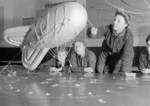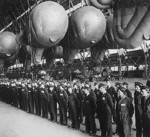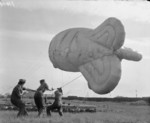RAF Barrage Balloon
| Country of Origin | United Kingdom |
| Type | Other Weapons |
Contributor: Alan Chanter
ww2dbaseThe purpose of the wartime barrage balloon was to prevent enemy aircraft from carrying out low-level bombing attacks against vulnerable areas, and to force such raiders to heights at which they could be more easily be engaged by anti-aircraft guns and fighter aircraft. The balloon barrage system was by no means a new idea. During the Great War the Italians had used balloons fitted with stabilizing fins to defend Venice from enemy air attacks. Great Britain and France had soon followed suit by adapting observation balloons on the Western Front for protection against attacking enemy aircraft.In 1936 the British Government decided to inaugurate a balloon barrage over London - the preliminary work, both technical and administrative being pressed forward with great speed. On 17 March 1937 the first balloon barrage group, No. 30, was formed commanded by a retired RAF Officer, Air Commodore J. G. Hearon, DSO, and this formation came under the overall operational control of Fighter Command, with manpower drawn from the Auxiliary Air Force - an organization similar to the part-time Territorial Army. A year later, it was decided to expand the scheme to other vulnerable points and populous areas in the country, particularly for the defence of important industrial and shipping areas. This expansion led to the establishment of RAF Balloon Command which came into existence on 1 November 1938, with Air Vice-Marshal O. T. Boyd as its first Air Officer Commanding (AOC). By the end of 1938 the first barrage balloons began appearing over the capital and by 1940 some 30,000 men were engaged in operating them.
Building the barrage would present numerous problems. Hundreds of balloons had to be manufactured and men trained to operate them. Suitable buildings for training and administration would be required and sites for positioning the balloons, for maximum effect, needed to be carefully plotted out. By the middle of 1939, out of forty A. A. F. squadrons some twenty-two squadrons had been committed to barrage balloon work.
The Balloons were manufactured at RAF Cardington in Bedfordshire, England, United Kingdom - a base that had a long history in building and operating balloons and airships. The barrage balloons, 66 feet long and 30 feet high when inflated, were tethered by a heavy steel cable to a winch on a six-wheeled lorry. The balloon envelopes were coated with an aluminium powder to reflect heat and made of a cotton fabric which was rubber-proofed to make it gas-tight. They were filled with 20,000 cubic feet of hydrogen gas, Stabilising fins helped provide lift and kept the balloon steady in flight. The hydrogen gas was stored in 500-pound canisters towed on a trailer behind the six-wheel winch lorry. A single balloon normally required a team of two corporals and ten airmen to maintain and operate it on shifts around the clock. After 1941 WAAF volunteers began substituting for male airmen as balloon operators in a ratio of 14 to nine. Providing hot meals to crews on permanent 24-hour readiness in isolated locations could prove rather a problem at first, but this was overcome by despatching food from a Flight Headquarters in thermostatic boxes.
Sites for the balloons could be in many out-of-way places. Some were stationed on coal wharves where men and equipment suffered from the all-pervading dust; others were placed in the grounds of large suburban houses, in dingy East-End backstreets or in West-End parks of London. Other would also be sited on such suitable places as greyhound racing tracks, football grounds, and golf course fairways. The barrage balloon units were not just meant to remain in static locations. Mobility was essential to allow redeployment to any other threatened area as required. On one occasion a German bombing raid on the Firth of Forth Bridge outside of Edinburgh, Scotland, United Kingdom, in October 1939, led to a complete barrage in Glasgow being hauled down, transferred by special trains and re-established within a day as protection for the vulnerable anchorage.
Before the war it had been realised that all estuaries leading to large ports and cities in Britain provided avenues through which enemy bombers could fly at low level to drop their loads accurately on targets. Something had to be done to close these gaps in the balloon defences and arrangements were made to fly the standard balloons from static barges in the estuaries. At first, 32 barges, each flying a single "low-zone" balloon, were moored in the Thames Estuary where the crews could often remain a number of days aboard. They covered a band of sea seven miles wide between Southend-on-Sea on the north bank to Sheerness on the south bank. However, it was found that these barges could not weather the rough seas at the far end of the estuary, and the plan was modified in December 1939 to a line running south from Shoeburyness, with the barges replaced by drifters - small fishing vessels equipped with engines. These were moored at twelve sites across the estuary.
The arrangements within these vessels were a truly British compromise. Each was manned by three or four RAF men to handle the balloon and its winch, while the drifter itself was under the control of a civilian crew. The civilian captain of each drifter was in overall command, even to the extent of ordering the RAF men to cut the balloon adrift should it be necessary. The drifters were actually too small to bed down the balloons, but they could be close-hauled by the winches.
The RAF men, part of 952 (Thames Barrage) Squadron, who worked on barges and drifters in the Thames Estuary usually stayed on board for about ten days before being relieved. The vessels were equipped with radio telephones and were visited regularly by supply boats. Of course, the estuary was a frequent target for minelaying by the Germans and, by the late summer of 1940, the introduction of acoustic mines and delay devices in magnetic mines would cause problems in sweeping the intricate waters.
With the fall of France the vital channel convoys became seriously threatened by German dive-bombers operating so much closer to England. To provide additional protection to the convoys the Mobile Barrage Balloon Flotilla was established to fly balloons from escorting trawlers crewed by Navy personnel with the RAF detachments responsible for operating the balloon. At first the balloons were flown at 3,500 feet, but German fighters simply shot them down while out of range of defensive fire, enabling the Stuka dive-bombers to attack many of the merchant ships. The operating height was then brought down to 2,000 feet, with the anti-aircraft guns set to burst their shells 500 feet above them. With greater experience among the ship's crews and better protection by Fighter Command, the convoys suffered fewer losses. One variation from the land based balloon was the use of the Mark VI "Very-low Altitude" kite balloon flown from smaller escort vessels. This was a smaller balloon with a gas capacity of 1,240 cubic feet and a cable length of 2,000 feet. They were also used to prevent enemy mine-laying in narrow estuaries.
When the Blitz began on 7 September 1940, the RAF had a fleet of 1,466 barrage balloons spread nationally among 52 operational squadrons (plus two more squadrons forming as mobile units), flying above Britain, a third of which defended London. By now Balloon Command was organised in five groups:
No.31 Group: Birmingham
No.32 Group: Romsey
No.33 Group: Sheffield
No.34 Group: Edinburgh
The balloons protected cities against the kind of devastation that Luftwaffe dive-bombers had unleashed on Warsaw in Poland and Rotterdam in the Netherlands. Any German pilot foolhardy enough to attempt a low-level bombing run through the barrage balloons risked being snagged by the metal cables tethering the balloons to the ground. Explosives were added that would be automatically detonated if the cable was touched. Although only 24 German planes were brought down by balloon cables, their real impact was greater. By forcing the Luftwaffe to fly at higher altitudes, the balloons sent bombers into the preferred range of anti-aircraft guns. The silent silver sentinels of the sky remained in place until the end of the war, a morale booster to British civilians every time they looked up.
On 5 February 1945 RAF Balloon Command was officially disbanded, although a number of balloons and their crews continued in service in other commands thereafter. Its last AOC was Air Vice-Marshal William Gell DSO, MC, a former officer in the Auxiliary Air Force.
Sources:
Chas Bowyer: Royal Air Force Handbook 1939-1945 (Ian Allan Ltd, 1984)
Major A. P. Le M. Sinkinson): Balloon Barrage over Britain (Library Press, Pictorial History of The War, Vol 4 pp187-190)
Juliet Gardiner: Wartime Britain 1939-1945 (Headline Books Publishing, 2004)
Scott Reeves: The Blitz - Anti-Aircraft Defences (Future Publishing Ltd, 2021)
Roy Conyers Nesbit: Failed to Return - Mysteries of the Air 1939-1945 (Patrick Stephens Ltd, 1988) ww2dbase
Last Major Revision: Sep 2021
RAF Barrage Balloon Interactive Map
Photographs
 |  |  |
Please consider supporting us on Patreon. Even $1 per month will go a long way! Thank you. Please help us spread the word: Stay updated with WW2DB: |
Search WW2DB
News
- » US Government Plans to Purge WW2 Information (17 Mar 2025)
- » WW2DB's 20th Anniversary (29 Dec 2024)
- » Wreck of USS Edsall Found (14 Nov 2024)
- » See all news
Current Site Statistics
- » 1,166 biographies
- » 337 events
- » 44,601 timeline entries
- » 1,243 ships
- » 350 aircraft models
- » 207 vehicle models
- » 376 weapon models
- » 123 historical documents
- » 261 facilities
- » 470 book reviews
- » 28,551 photos
- » 375 maps
Famous WW2 Quote
"An appeaser is one who feeds a crocodile, hoping it will eat him last."Winston Churchill
Support Us
Please consider supporting us on Patreon. Even $1 a month will go a long way. Thank you!
Or, please support us by purchasing some WW2DB merchandise at TeeSpring, Thank you!